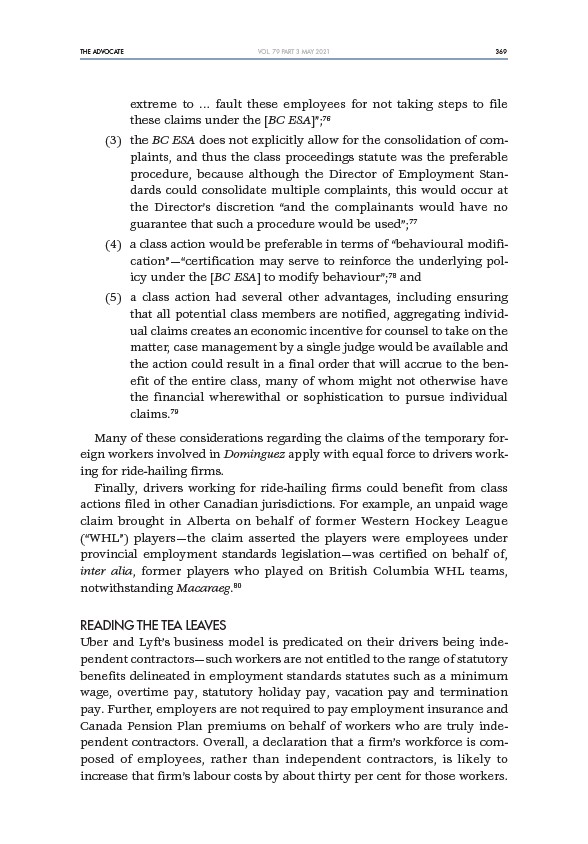
THE ADVOCATE 369
VOL. 79 PART 3 MAY 2021
extreme to … fault these employees for not taking steps to file
these claims under the BC ESA”;76
(3) the BC ESA does not explicitly allow for the consolidation of complaints,
and thus the class proceedings statute was the preferable
procedure, because although the Director of Employment Standards
could consolidate multiple complaints, this would occur at
the Director’s discretion “and the complainants would have no
guarantee that such a procedure would be used”;77
(4) a class action would be preferable in terms of “behavioural modification”—“
certification may serve to reinforce the underlying policy
under the BC ESA to modify behaviour”;78 and
(5) a class action had several other advantages, including ensuring
that all potential class members are notified, aggregating individual
claims creates an economic incentive for counsel to take on the
matter, case management by a single judge would be available and
the action could result in a final order that will accrue to the benefit
of the entire class, many of whom might not otherwise have
the financial wherewithal or sophistication to pursue individual
claims.79
Many of these considerations regarding the claims of the temporary foreign
workers involved in Dominguez apply with equal force to drivers working
for ride-hailing firms.
Finally, drivers working for ride-hailing firms could benefit from class
actions filed in other Canadian jurisdictions. For example, an unpaid wage
claim brought in Alberta on behalf of former Western Hockey League
(“WHL”) players—the claim asserted the players were employees under
provincial employment standards legislation—was certified on behalf of,
inter alia, former players who played on British Columbia WHL teams,
notwithstanding Macaraeg.80
READING THE TEA LEAVES
Uber and Lyft’s business model is predicated on their drivers being independent
contractors—such workers are not entitled to the range of statutory
benefits delineated in employment standards statutes such as a minimum
wage, overtime pay, statutory holiday pay, vacation pay and termination
pay. Further, employers are not required to pay employment insurance and
Canada Pension Plan premiums on behalf of workers who are truly independent
contractors. Overall, a declaration that a firm’s workforce is composed
of employees, rather than independent contractors, is likely to
increase that firm’s labour costs by about thirty per cent for those workers.